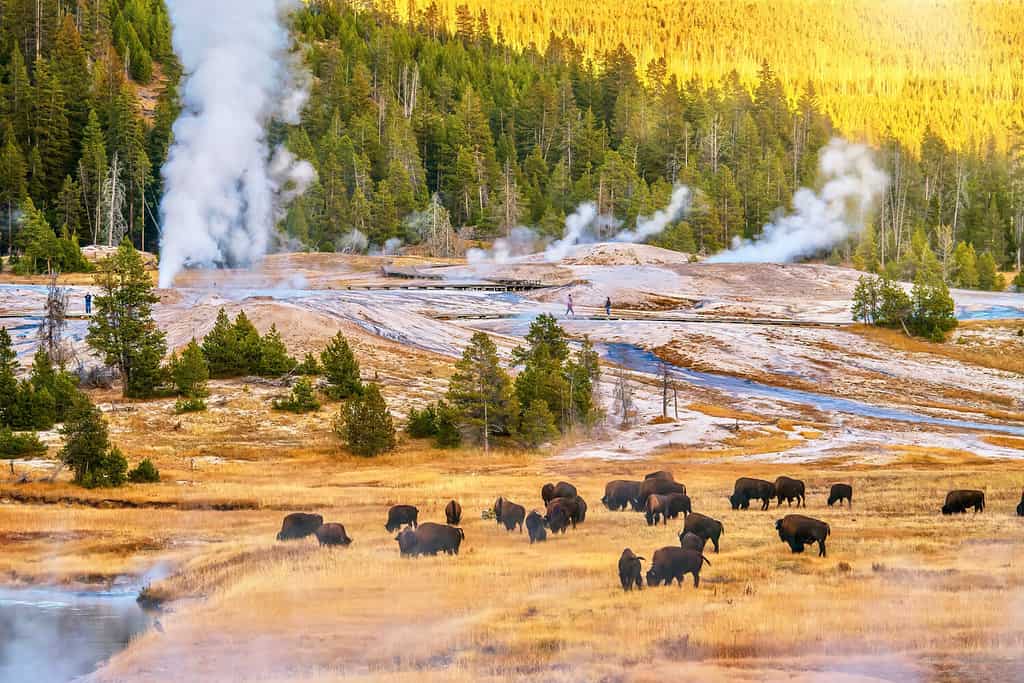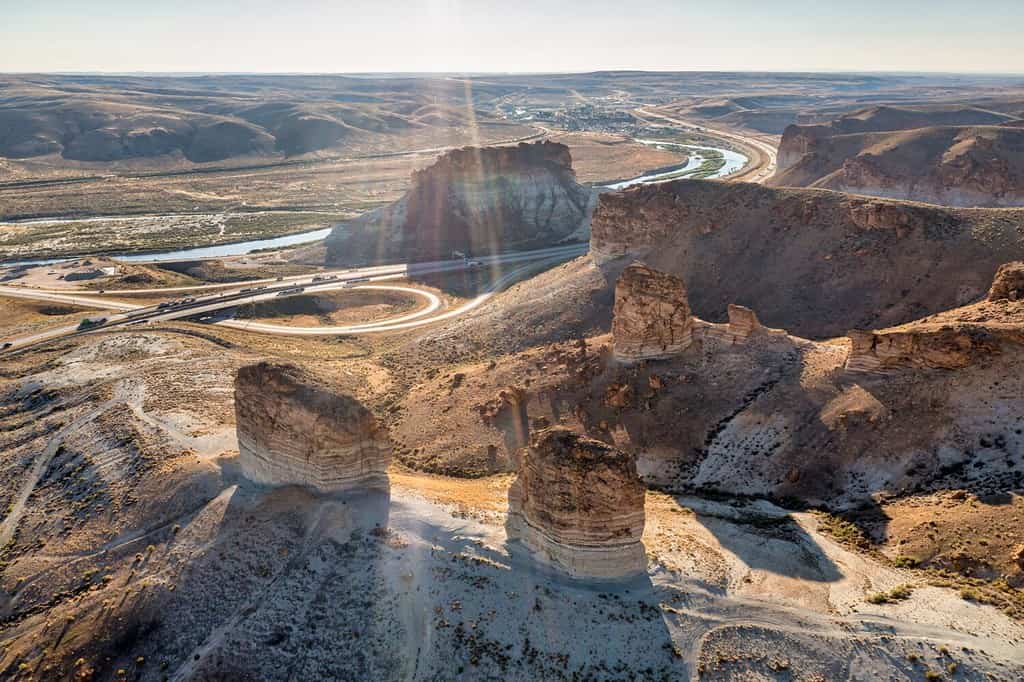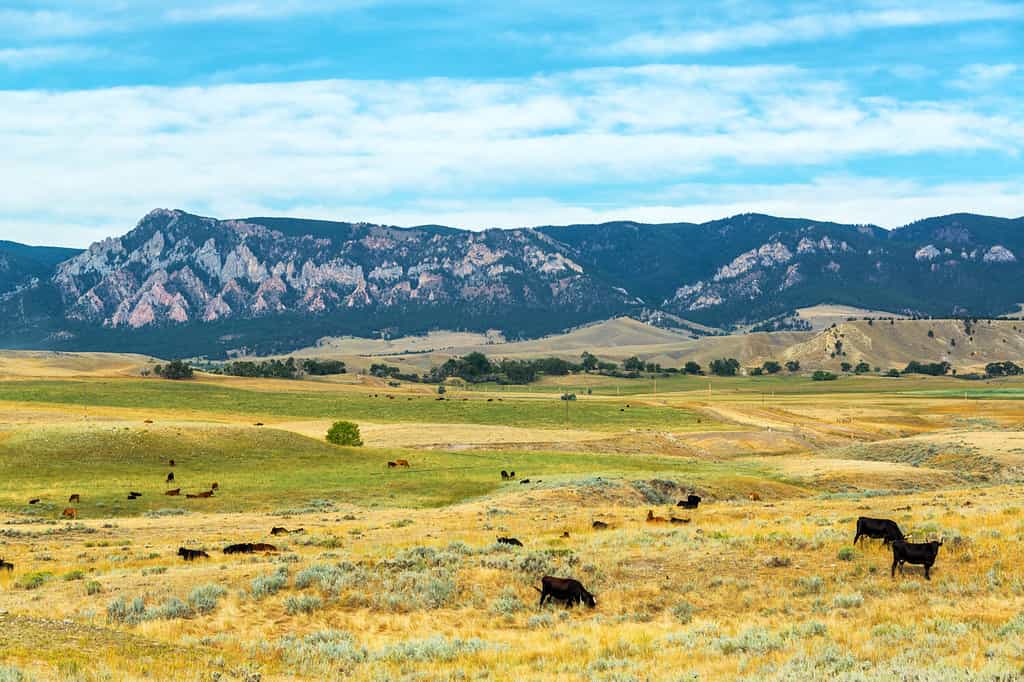Within the heart of the American West, Wyoming contains an expansive landscape filled with biodiversity. In this land of rugged mountains, vast plains, and other unique natural geographical features, the dimensions of Wyoming reveal a captivating natural diversity and ecological richness. While it may not claim the title of the widest state in the nation, Wyoming’s width remains a defining feature. This article will explore how wide Wyoming is, how its size compares to other states, its overall geography, and more.
How Wide Is Wyoming?

Wyoming is approximately 375 miles (603 kilometers) wide from east to west and 276 miles (444 kilometers) long from north to south.
©(c) Sean Board/iStock via Getty Images
Wyoming, a state located in the western United States, is best known for its vast landscapes and natural beauty. Overall, its shape is consistent with a classic rectangle.
Wyoming Width from East to West
Wyoming spans a considerable distance from its eastern border to its western border. The width of Wyoming from east to west is approximately 375 miles (603 kilometers). This measurement captures the expanse of the state, showcasing the diverse range of ecosystems and terrains that it encompasses.
Widest and Narrowest Points
Wyoming is not a perfect rectangular shape, but it’s closer to it than any other state. There are minor variations in its width from east to west when comparing its north end to south end. You can measure the widest point of Wyoming from east to west in the southern part of the state. On the other hand, the narrowest point of Wyoming from east to west is in the northern part of the state by a matter of less than 50 miles.
Wyoming’s diverse geography, which includes not only the vast plains of the Great Basin but also the towering peaks of the Rocky Mountains, contributes to these variations in width. It is a state where one can witness the beauty of both wide-open spaces and rugged mountain terrain.
Overall, Wyoming’s width from east to west measures approximately 375 miles, with its widest point being its south end and its narrowest point being its north end. Similar to Colorado, Wyoming is the closest to a perfect rectangle shape than any other state.
Geography of Wyoming

©CherylRamalho/Shutterstock.com
The Rocky Mountains run through Wyoming and are categorized into different ranges. They include the Teton Range, the Absaroka Range, the Wind River Range, the Wyoming Range, the Owl Creek Mountains, the Bighorn Mountains, the Laramie Mountains, and the Medicine Bow Mountains.
Topography and Landforms
Wyoming is a state characterized by its varying topography, ranging from expansive plains to towering mountain ranges.
The Rocky Mountains dominate the northwestern part of the state, with the Teton Range, Absaroka Range, Wind River Range, Wyoming Range, and Owl Creek Mountains carving dramatic peaks into the skyline. The state’s highest point, Gannett Peak, stands proudly at 13,804 feet (4,207 meters) above sea level, residing in the Bridger-Teton National Forest. Furthermore, the Bighorn Mountains reside in the north-central region of the state.
In contrast, Wyoming’s eastern and southern parts feature predominately vast, high plains and basins. This region is also home to the smaller Laramie Mountains and the Medicine Bow Mountains. Moreover, the Great Plains runs through the eastern side of Wyoming. The Great Plains are known for their wide-open spaces and significant role in agriculture and ranching. The Great Divide Basin, a unique geographical feature, is situated in the southwestern part of the state. Rainwater that falls within this basin does not drain to either the Atlantic or Pacific Ocean, making it an endorheic basin.
Rivers and Watersheds
Wyoming is home to several vital river systems that are crucial to the region’s ecology and agriculture. The Yellowstone River, originating in the Absaroka Mountains, flows through the northwestern part of the state and eventually joins the Missouri River. The Snake River, fed by the melting snows of the Rocky Mountains in Yellowstone National Park, winds its way through the western valleys before heading into Idaho and eventually joining the Columbia River in Lake Wallula.
The North Platte River, originating in Colorado, passes through Wyoming in the state’s southeastern part and flows northward before ending in Nebraska. The Platte River, formed by the confluence of the North Platte and South Platte Rivers in Nebraska, was historically an important river for pioneers traveling westward.
Yellowstone National Park
One of Wyoming’s most renowned geographic treasures is Yellowstone National Park, the world’s first national park. This national Park was established in 1872. This vast wilderness area spans parts of Wyoming, Montana, and Idaho. It is home to iconic geothermal features, including the famous Old Faithful cone geyser, as well as its diverse wildlife, such as elk, grizzly bears, wolves, and herds of bison. The Yellowstone Caldera, a volcanic caldera and supervolcano, resides in the northwest corner of Wyoming and is responsible for the geothermal activity in this region.
Desert and Plateaus
In the south-central region of Wyoming, the Red Desert stretches across a vast expanse of high-altitude desert and sagebrush steppe. This unique region experiences arid and semi-arid landscapes, as well as striking rock formations. The Flaming Gorge Reservoir, the largest reservoir in Wyoming, resides along the Green River. Rugged canyons and desert terrain surround this stunning body of water.
Climate
Wyoming experiences arid, semi-arid, continental, and alpine climates. However, it primarily experiences semi-arid and continental climates characterized by more significant temperature extremes with cold winters and warm summers, in addition to drier and windier conditions compared to the rest of the United States. The high elevations of the state contribute to its colder temperatures. The eastern plains are drier and have a semi-arid climate. At the same time, the western mountains receive more precipitation, creating lush forests and alpine meadows.
Overall, Wyoming’s geography holds a variety of diverse landscapes, from the soaring peaks of the Rocky Mountains to the vast, open plains of the Great Plains. Its rivers and watersheds sustain both wildlife and agriculture. Its unique features, like the Yellowstone Caldera, make it a geological marvel. The state’s climate, influenced by its elevation and topography, adds to its diverse makeup. Wyoming’s geography is a testament to the classic natural beauty of this region of the American West.
Overall Size of Wyoming

©anthony heflin/Shutterstock.com
Wyoming is home to the iconic Teton Range, which resides within the Grand Teton National Park and extends for approximately 40 miles in a north-to-south direction.
Total Surface Area
Wyoming covers a total land area of approximately 97,914 square miles (253,596 square kilometers). This extensive landmass positions it as one of the largest states in the United States in terms of land area. Moreover, it is considered the 9th largest state in the country. It is surpassed in size by a handful of western states, such as Alaska, Texas, California, Montana, New Mexico, Arizona, Nevada, and Colorado.
Length from North to South
Wyoming stretches over a considerable distance from its northern to its southern border. The length of the state from north to south is approximately 276 miles (444 kilometers). This measurement highlights the vertical expanse of Wyoming, which encompasses diverse ecosystems and terrain types, from the rugged mountains and plains of the north to the deserts and plains of the south.
Percentage of the Country’s Total Land Area
To understand Wyoming’s size, aside from how wide it is when compared to the size of the entire United States, it’s helpful to consider its percentages. The total land and water area of the United States adds up to approximately 3,809,525 square miles (9,866,624 square kilometers). Wyoming accounts for approximately 2.57% of the total land and water area of the United States. While this may seem relatively small in comparison to the vastness of the entire nation, it’s essential to recognize that nine other states outrank Wyoming by total surface area, such as Alaska, which has a total surface area of approximately 665,400 square miles (1,723,378 square kilometers).
With its significant land and water area and the vertical stretch from north to south, Wyoming’s overall size plays a small but vital role in the nation’s geography. While it accounts for a relatively small percentage of the United States’ total land and water area, its geographical location provides vast and diverse landscapes, making it a treasure trove of natural beauty and ecological significance.
How Wide and Long Are Other States?

©RodClementPhotography/Shutterstock.com
Wyoming is home to many diverse and dramatic landscapes, from arid deserts in the southeast to alpine meadows in the northwest, and everything in between.
Neighboring States of Wyoming: Width from East to West
Wyoming shares its borders with several states, each with its own unique widest point from east to west. First, Montana, to the north of Wyoming, boasts a significant width from east to west, spanning approximately 630 miles (1,014 kilometers). Next, to the west of Wyoming, Idaho stretches about 305 miles (491 kilometers) from its eastern border to its western border. To the southwest of Wyoming, Utah extends roughly 270 miles (435 kilometers) from east to west. Moving on to the northeast of Wyoming, South Dakota extends approximately 380 miles (612 kilometers). Next, to the east of Wyoming, Nebraska covers an east-to-west width of about 430 miles (692 kilometers). Lastly, to the south of Wyoming, Colorado also stretches approximately 380 miles (612 kilometers).
Top Three Widest States in the United States From East to West
The top three widest states in the United States, measuring from east to west, may depend on different measurement methods. If you’re measuring a straight line, including water area, Alaska claims the spot as the widest state in the United States from east to west. Alaska is also the largest state in the United States by area. Its width from east to west measures approximately 2,400 miles (3,862 kilometers). Its vast expanse encompasses many diverse landscapes. Hawaii claims the second spot as one of the widest states in the United States from east to west. This is because if you measure from its easternmost island to its westernmost island, the total distance equates to approximately 1,500 miles (2,414 kilometers). Third is Texas, which is often associated with vastness. It covers an impressive width of roughly 773 miles (1,244 kilometers) from its eastern border to its western border.
Neighboring States of Wyoming: Length from North to South
Turning our attention to the lengths of Wyoming’s neighboring states from north to south, Montana’s north-to-south length measures approximately 255 miles (410 kilometers), extending from its northern border to its southern border. Next, to the south of Wyoming, Colorado spans about 280 miles (451 kilometers) from its northernmost point to its southernmost point. Utah, located southwest of Wyoming, has a north-to-south length of roughly 350 miles (563 kilometers). South Dakota, meanwhile, to the northeast of Wyoming, spans approximately 210 miles (338 kilometers) from its northern tip to its southernmost point. Moving west of Wyoming, Idaho stretches about 479 miles (771 kilometers) from north to south. Lastly, to the east of Wyoming, Nebraska measures 210 miles (338 kilometers) north-to-south.
Top Three Longest States in the United States From North to South
When measuring from north to south, the top three longest states in the United States are to be expected. Once again, Alaska takes the top spot, with a staggering north-to-south length of approximately 1,420 miles (2,285 kilometers). Second, this time in Texas, which extends approximately 801 miles (1,290 kilometers) from its northern border to its southern border. Third is California, which ranks among the longest states, with a north-to-south length of around 760 miles (1,223 kilometers).
Understanding the dimensions of states provides a deeper appreciation for the varied landscapes and geographical features found within the United States. From the wide expanses of Alaska to the diverse terrain of Wyoming or Texas, each state contributes to the geographical makeup of the nation.
List of Wyoming’s Size Compared to Other States
| State | Width (East to West) | Length (North to South) | Surface Area |
|---|---|---|---|
| Wyoming | 375 miles (603.5 kilometers) | 276 miles (444 kilometers) | 97,814 square miles (253,340 square kilometers) |
| Colorado | 380 miles (612 kilometers) | 280 miles (451 kilometers) | 104,185 square miles (269,838 square kilometers) |
| Utah | 270 miles (435 kilometers) | 350 miles (563 kilometers) | 84,899 square miles (219,890 square kilometers) |
| Idaho | 305 miles (491 kilometers) | 479 miles (771 kilometers) | 83,570 square miles (216,400 square kilometers) |
| Nebraska | 430 miles (692 kilometers) | 210 miles (338 kilometers) | 77,220 square miles (199,999 square kilometers) |
| South Dakota | 380 miles (612 kilometers) | 210 miles (338 kilometers) | 77,116 square miles (199,730 square kilometers) |
| Montana | 630 miles (1,014 kilometers) | 255 miles (410 kilometers) | 147,040 square miles (380,800 square kilometers) |
| Alaska | 2,400 miles (3,862 kilometers) | 1,420 miles (2,285 kilometers) | 665,400 square miles (1,723,379 square kilometers) |
| Hawaii | 1,500 miles (2,414 kilometers) | 95 miles (153 kilometers) | 6,423 square miles (16,637 square kilometers) |
| Texas | 773 miles (1,244 kilometers) | 801 miles (1,290 kilometers) | 268,597 square miles (695,663 square kilometers) |
| California | 250 miles (400 kilometers) | 760 miles (1,223 kilometers) | 163,696 square miles (423,970 square kilometers) |
Wildlife in Wyoming

©Jess Kraft/Shutterstock.com
Across Wyoming’s vast and stunning landscapes in an expanse of remarkable biodiversity. Many iconic species roam these lands, including American bison, Rocky Mountain elk, moose, grizzly bears, black bears, cougars, Rocky Mountain bighorn sheep, and many more.
Iconic Mammals
Wyoming’s wildlife is as diverse as its terrain. The state is home to many iconic mammals, including the American Bison, which is also the state mammal. These majestic creatures roam freely in places like Yellowstone National Park and the Grand Teton National Park. Additionally, the state is home to Rocky Mountain elk, pronghorn, and Rocky Mountain bighorn sheep. Grizzly bears and black bears also inhabit the rugged mountain regions.
Birds of Prey
Wyoming is a paradise for birdwatchers, home to a variety of raptors and birds of prey. The state’s open spaces provide ideal habitats for bald eagles, golden eagles, and red-tailed hawks. The sage grouse, an emblematic bird of the American West, is a species of concern due to its habitat requirements, and conservation efforts are underway to protect it.
Aquatic Life
Wyoming’s rivers and lakes are also teeming with life. Native cutthroat trout thrive in clear mountain streams, while larger game fish like rainbow trout and brown trout attract anglers from around the world. The Snake River fine-spotted cutthroat trout, in particular, is a sought-after catch among fly-fishing enthusiasts.
Reptiles and Amphibians
Although often overshadowed by the state’s charismatic larger animals, Wyoming is also home to an array of reptiles and amphibians. You can find western-painted turtles sunning themselves on logs in wetland areas. Some of the reptilian residents are garter snakes, bull snakes, and prairie rattlesnakes. Amphibians like the northern leopard frog and boreal chorus frog can be heard in the state’s marshy areas.
Small Mammals and Rodents
Wyoming’s wildlife extends beyond the large and iconic species, too. The state hosts a variety of smaller mammals and rodents that play vital roles in the ecosystem. These include the Wyoming ground squirrel, Uinta chipmunk, and yellow-bellied marmot. The dwarf shrew, meadow vole, and various species of bats also contribute to the state’s rich biodiversity.
Predators and Carnivores
Wyoming is no stranger to predators and carnivores that play crucial roles in maintaining ecological balance. Alongside the aforementioned bears, the state is home to the elusive mountain lion, or cougar, which silently roams the mountainous terrain. Moreover, coyotes are a common sight, while the rarely-sighted lynx, with its tufted ears, calls the state’s dense forests home.
Endangered and Threatened Species
Like many regions, Wyoming faces the challenge of conserving its endangered and threatened species. The black-footed ferret once thought extinct, has been successfully living in parts of the state. The Wyoming Toad, one of the most endangered amphibians in North America, is the focus of extensive recovery efforts. It now only exists in captivity within the Mortenson Lake National Wildlife Refuge in Wyoming.
Conservation Efforts
Wyoming takes its role as a custodian of Earth seriously. The state government, in collaboration with various organizations, actively engages in conservation efforts to protect its wildlife and their habitats. For example, the Wyoming Game and Fish Department manages certain wildlife populations and promotes sustainable hunting and fishing practices.
Overall, the state of Wyoming is filled with natural richness and ecological diversity, from the grandeur of the American bison to the delicate beauty of native trout species. Preserving the natural heritage of Wyoming’s wildlife and landscapes is essential to protecting the Earth on a hyper-local level.
Conclusion
In conclusion, Wyoming, which resides in the heart of the American West, reveals a vast expanse as the 9th largest state in the United States. From east to west, Wyoming is approximately 375 miles (603 kilometers) wide. Its width is characterized by a diverse landscape that encompasses rugged mountains, expansive plains, unique geological wonders, and iconic wildlife. Wyoming’s dimensions may not be the largest in the nation. However, its size underscores the remarkable geographical diversity that defines the state.
The photo featured at the top of this post is © Sierralara/Shutterstock.com
Thank you for reading! Have some feedback for us? Contact the AZ Animals editorial team.






